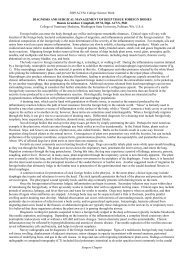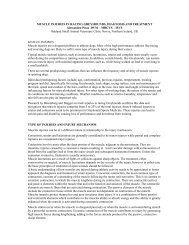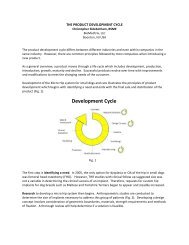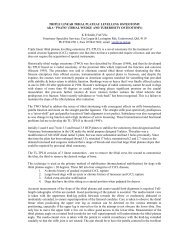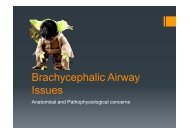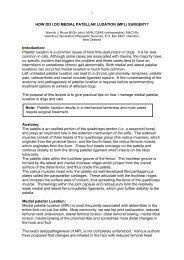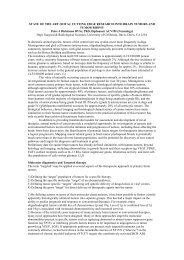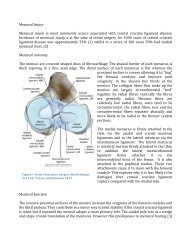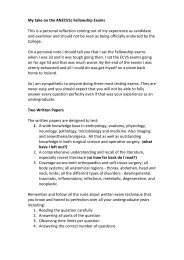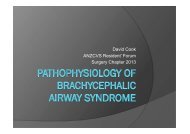INTRA-ARTICULAR FRACTURES OF THE DISTAL RADIUS ...
INTRA-ARTICULAR FRACTURES OF THE DISTAL RADIUS ...
INTRA-ARTICULAR FRACTURES OF THE DISTAL RADIUS ...
You also want an ePaper? Increase the reach of your titles
YUMPU automatically turns print PDFs into web optimized ePapers that Google loves.
<strong>INTRA</strong>-<strong>ARTICULAR</strong> <strong>FRACTURES</strong> <strong>OF</strong> <strong>THE</strong> <strong>DISTAL</strong> <strong>RADIUS</strong>Alessandro Piras DVM, MRCVS, ISVSOakland Small Animal Veterinary Clinic Newry, Northern Ireland, UKRadial Styloid FracturesThese are uncommon intra-articular fractures. They are avulsion injuries of the origin of the short radialcollateral ligament. Normally it provides medial stability for the antebrachiocarpal joint in both flexion andextension. This ligament has two components originating on a tubercle on the styloid process and insertingrespectively on the medial (straight portion) and palmaro-medial (oblique portion) aspects of the radialcarpal bone. These fractures are treated by open reduction, accurate anatomical realignment and internalfixation. The surgical exposure is made with a longitudinal incision directly over the styloid process.Several fixation techniques have been described, including K wires with a figure of eight tension bandwire for the small fragments, multiple divergent K wires or lag screws and anti rotational K wires for largerfragments. Very small fragments can be excised.When inserting the K wires is always advisable, in order to achieve a better stability, to drive them from thefragment across the metaphyseal bone into the far cortex.Ulnar Styloid Process FracturesThe ulnar styloid process, in association with the radial styloid, buttresses the proximal carpal bones. Theshort ulnar collateral ligament and the palmar ulno- carpal ligament originate in the ulnar styloidproviding lateral and palmar stability for the joint. Fractures of the ulnar styloid can be divided in twotypes; fractures affecting the proximal portion of the styloid, usually 1 to 3 cm from its distal end andfractures of the distal portion characterized by a small avulsed fragment.Ulnar styloid fractures are not necessarily intra-articular and if incomplete, can be treated conservativelywith external coaptation. Complete fractures can be associated with antebrachiocarpal subluxation, luxationof the radial carpal bone or accompanied by fracture of the radial styloid; in any case they require openreduction and internal fixation.Technique of choice is generally K wires with a figure of eight tension band wire for distal fractures andIM pinning or small lateral plate ( 2.0\2.7 VCP or DCP) for more proximal fractures .A post operative bandage is usually recommended to support the repair of styloid fractures, restricted andcontrolled activity until radiographic signs of healing are evident. Implants are left in situ unless theybecome loose or are irritating the soft tissues.Dorsal Articular Margin Fractures of Distal RadiusFractures of the distal articular radius can occasionally involve the central or lateral portions of the articularsurface. As for any other intra articular fracture, open reduction and rigid, “gap free” internal fixation is thegolden rule.This fracture of the dorsal articular margin of the radius was first described by Ferguson (1986) in racingGreyhounds. Although not common in the canine pet population, is has been described in other sportingbreeds. The following description on diagnosis and treatment of this injury is focused on the racingGreyhound.They are one of the most common fractures of the front limb in the author’s experience. These fractures arealmost invariably located at the origin of the dorsal radio-carpal ligament that joins the dorsal articularmargin of the radius with the ulnar carpal bone.The fracture can consist of a single fragment (2 to 10 mm), multiple fragments of variable size or it can bean incomplete fracture extending into the metaphyseal bone.The history can be quite subtle; usually the trainer reports that the dog was checking in the bends andrunning wide. The lameness affects the dog for the first 24\36 hours after trial or race but the dog is alwaysweight bearing. Almost consistently, the trainer reports that after a few days the dog looks normal but islame again after a gallop or a trial.
The clinical examination reveals pain in flexion, as well as internal and external rotation of the carpus.Cranial translation with the joint at 90 degrees of flexion elicits a variable pain response. Contrary toexpectations, swelling is not a constant finding and identifying the lesion by the application of directpressure does not necessarily provoke a pain response from the dog.Radiographic examination consists of multiple views including standard and oblique views. Some authorsdescribe the straight medio-lateral as the best diagnostic view. However, in my experience this is notalways reliable as some fractures can be appreciated only with skyline views taken at different angles.The fracture is exposed with a small incision made directly between the extensor carpi radialis and thecommon digital extensor tendons. Surgical removal of small fragments by curettage of the lesion, or lagscrew fixation of larger fragments and incomplete fractures offers the best prognosis. Removing the smallfragments creates damage to the dorsal radio-carpal ligament that heals with the formation of fibrous tissue.The involvement of this small ligament in the etiopathogenesis of this type of fractures and its role in thejoint stability is yet to be clarified.After the surgery a light bandage is applied on the carpus for 10 days. After suture removal, a light bandageis reapplied for another 15 days and light exercise and physiotherapy is encouraged. The dog is expected torestart training between 6 and 10 weeks after surgery.



